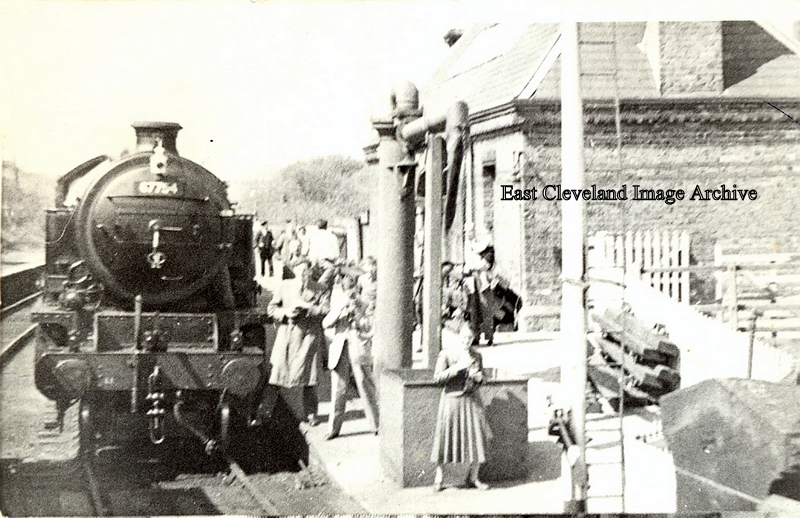
Loftus Station on the last day of through passenger services to Scarborough on the Coast Line, May 1958.
Image courtesy of Alan Richardson
|
|
||
 Loftus Station on the last day of through passenger services to Scarborough on the Coast Line, May 1958. Image courtesy of Alan Richardson 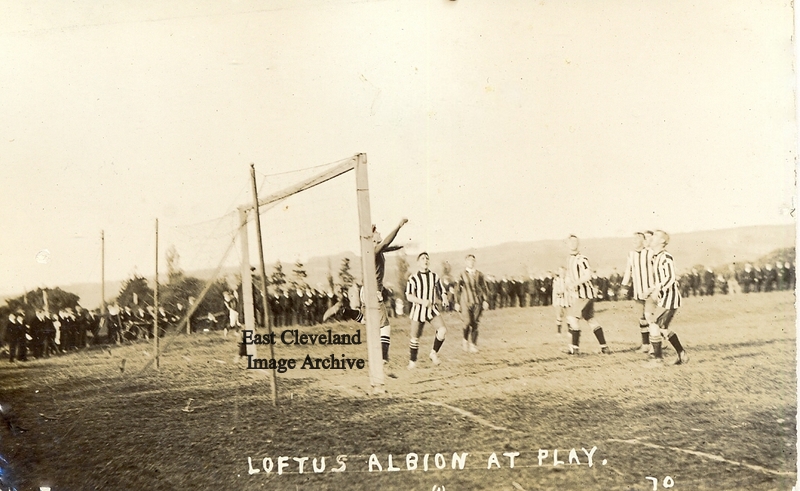 Loftus Albion playing at home on their Whitby Road ground; in black and white striped shirts. They reached the semi final of the F.A. Amateur Cup, from the Cleveland League. Narrowly losing to Bishop Auckland 2 -1 after leading through a Bobby Pitt goal. They were accepted into the Northern League on the strengh of this performance. Photograph courtesy Alan Richardson. 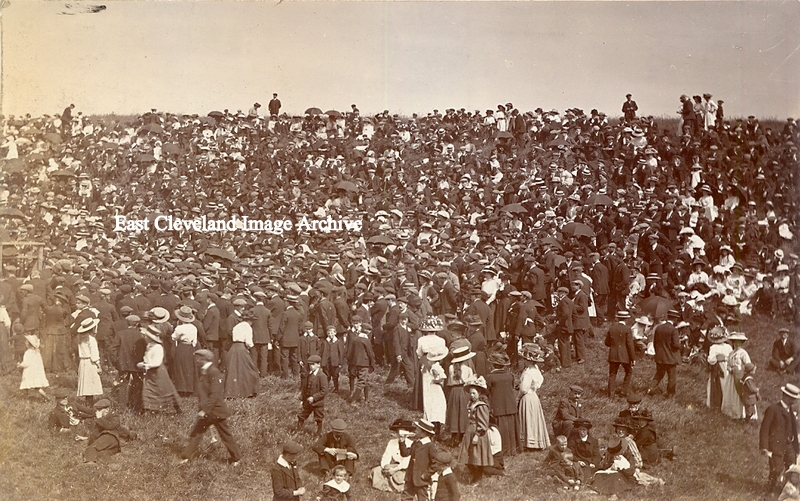 A gathering of people in Loftus, probably part of the Peace Celebrations in 1919. The crowd sport a plethora of head gear; flat caps, straw boaters, bonnets, and magnificent ladies hats. Only the small boys at the front of the photograph are bareheaded. Most people are paying attention to the speakers platform on the left of the image. Location in Loftus not known, but believed to have been in the Foulsyke area. Photograph courtesy Alan Richardson. 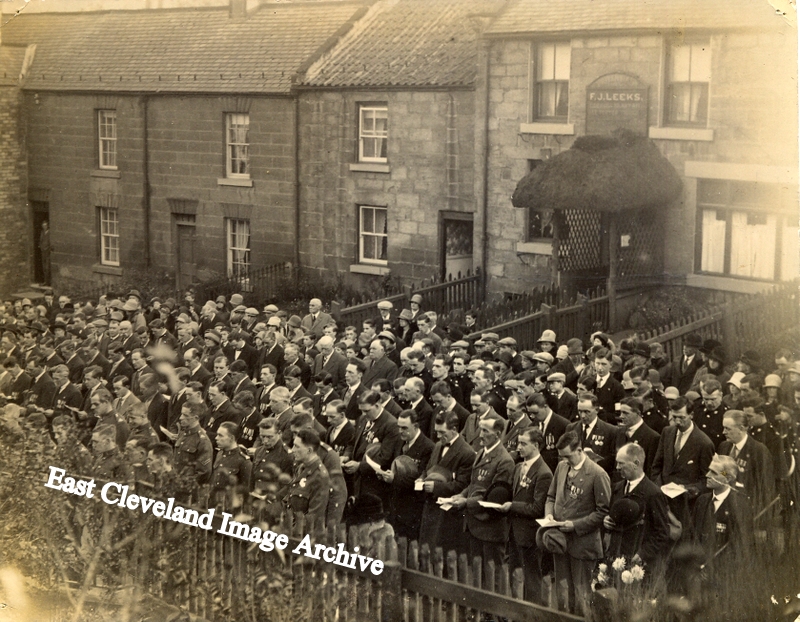 Veterans of the Great War, mustered at Loftus War Memorial. Many are still young men with memories still fresh of the horror they endured, as they honour fallen comrades. Several wear the 1914/15 Star, meaning they served as volunteers. Norman Patton tells us: ”One lady who was definitely at this parade was Elizabeth Ann Hicks, wife of the late William Hicks, of 29 Tees Street, Loftus. They had two sons who went ’Missing in Action’ in World War I. They were William Arthur: remembered at the Menin Gate and Charles Edwin: remembered at Thiepval. Both are also remembered on the memorial at Loftus. Elizabeth had a daughter, Alice May Hicks, who served with the Military Nursing Service in Egypt during the same war. She met and fell in love with Thomas Brooke Stanley who had been injured while fighting with the 10th Australian Light Horse Infantry at Hill 60 in Gallipoli, where he was decorated for his bravery. After the war ended, Tom came to Loftus to seek permission to marry Alice. She followed him back to Australia where they married and settled in Brunswick Junction, Western Australia; and together they became successful farmers. Elizabeth Ann Hicks and her family had made huge sacrifices in that war. She was my great grandmother.” “We Shall Remember Them.” Norman further advised: “My great grand mother’s maiden name was Elizabeth Ann Cammell. She was the daughter of Michael who was a veterinary who practiced in Sculcoates near Hull. Ann married William Hicks who’s parents had farmed at Forresters Lodge in Little Fryup Dale. William was a time served carpenter and Ann was a milliner and dressmaker who spent most of her life assisting her brother Charles Cammell and his wife Albina who had the business next to the Golden Lion in the market place. Charles and his family lived at 6 Zetland Terrace.” Thelma reports: “Charles Edwin Hicks was my grandfather and I have been researching our family tree and am thrilled to get some more information about great grandparents. We have a photograph of my Grandfather and are checking out his war records. We were always told he was killed by a sniper whilst delivering a message. He was a good runner. I have recently been contacted by relatives in Australia keen for information so will pass on the news his sister also emigrated to Australia.” Image courtesy of Alan Richardson; many thanks to Norman Patton and Thelma for the supporting information. 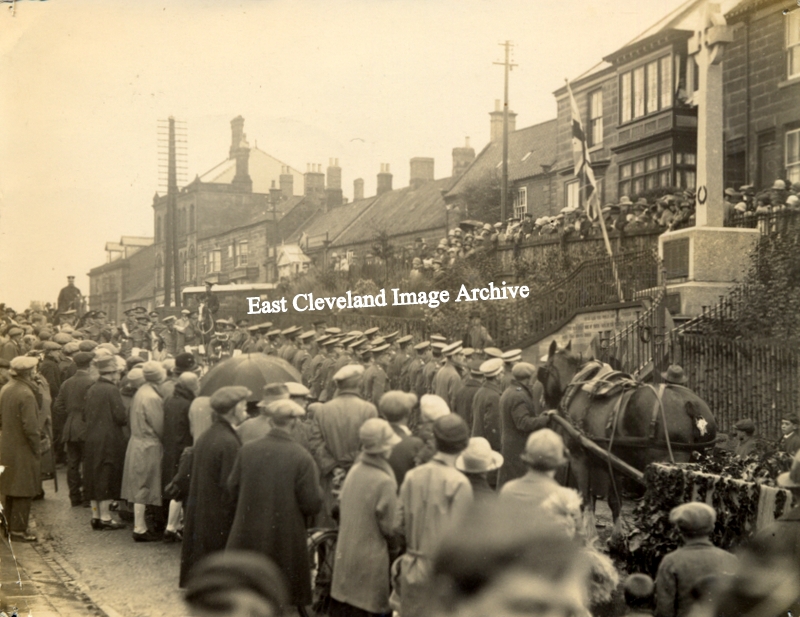 A rainy Remembrance Day with the cenotaph Parade in the late 1920s; note the decorated cart at the right of the photograph – purpose unknown – can anyone help with details. Photograph courtesy of Alan Richardson. 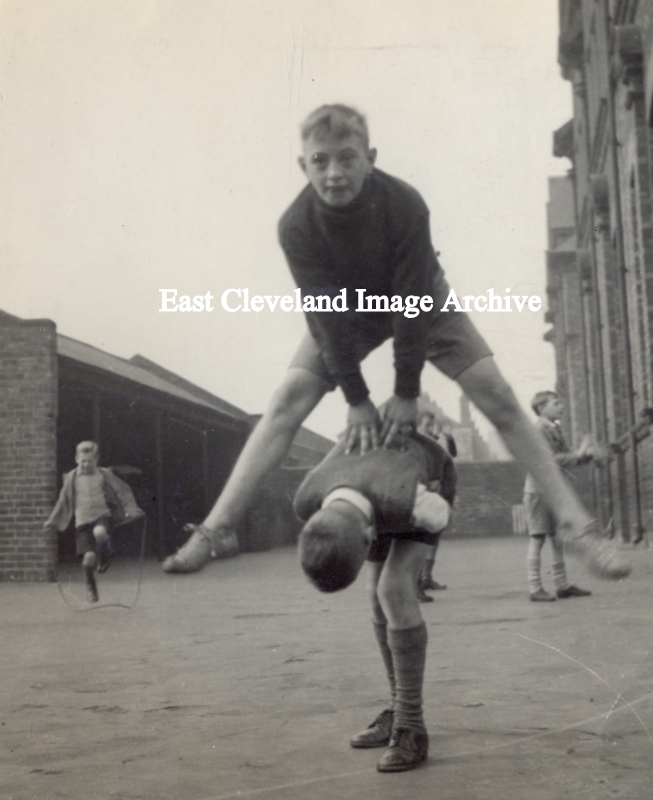 Fleetham Street School playground, Redcar; two boys play at leapfrog, in the background a lad practices his skipping. Photograph courtesy of Alan Richardson. 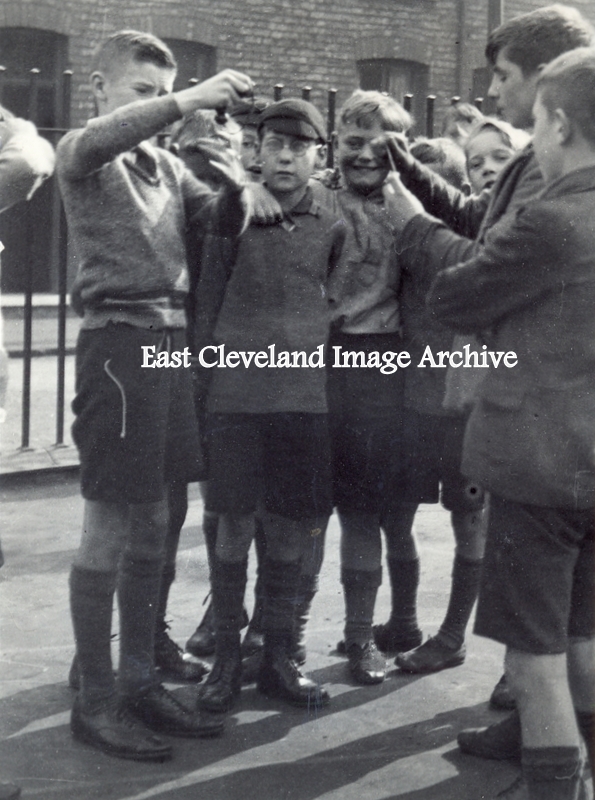 An activity now frowned upon by the ”elf and safety” mob; the pupils of Fleetham Street School, Middlesbrough play conkers about 1938. Photograph courtesy of Alan Richardson. 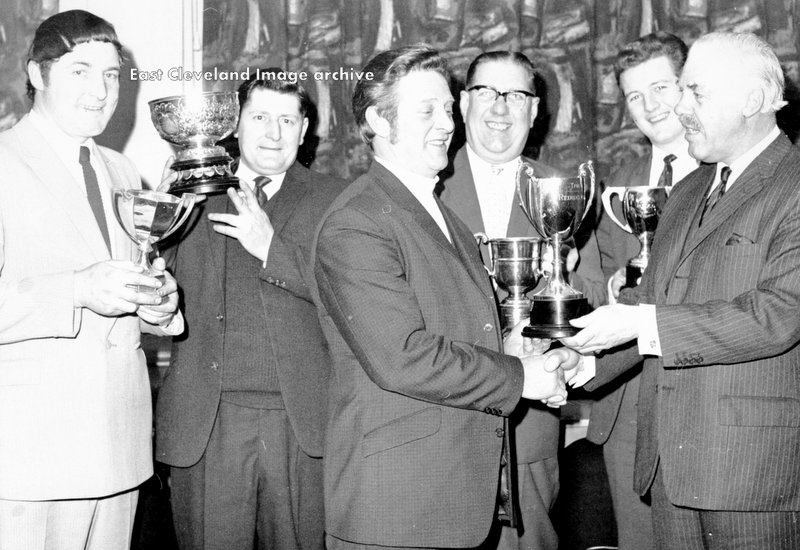 Mr Paul Redway is presenting Brian Cook with a beautiful cup, but what is it for and who are the other men with their cups and what are they for. HELP is definitely needed. Left to right: ??, ??, Brian Cook, Jack Harrison, Colin Sherwood, Paul Redway. Geoff Bailey advised: “I used to live next door to Paul Redway. He lived with his wife, daughter and two sons in the white cottage 98 Belmangate, Guisborough.” Image courtesy of Dave McGill; thanks to Bob Doe for the names and to Geoff Bailey for the update. 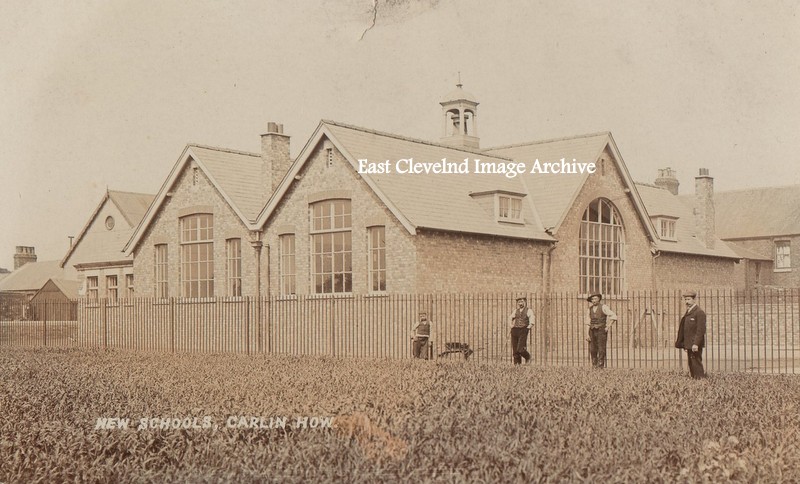 The new school Carlin How opened in 1907, the ceremony was performed by Colonel Legard; Chairman of the North Riding Education Committee. The builder was J. G. Porteus of Guisborough. Bill Kitching tells us: ”I attended Carlin How School when I was three years (Friday afternoons for one hour) then Baby Class at age of five years in 1927. I passed the eleven plus examination in 1933 to go to Guisborough Grammar School. The Headteacher was Miss Keen, Baby Class teacher was Miss Richardson, Class 2 was Miss Birtwhistle, Class 3 was Miss Hall, Class 3A was Miss Stanlake and Class 4 (top class!) was Miss Thompson. Wonderful teachers!” Whilst Derick Pearson tells us: ”I left the same year as Bob but I too remember another teacher who may have left a year or two before. Her name was Miss Keen; who Bill said was there in 1933. But I did not think she was Head Mistress, I’m certain Lena? Thompson was. Did Miss Keen step down? Somethings at the back of my mind about her going to Africa perhaps. Can anyone remember? Miss Keens class was same side and up the Hall from Miss Thompsons, Miss Potters was opposite side and Miss Garners was in the main hall too. Miss Tweddle who came much later was along the corridor in the Annex if I remember correctly. Did she take Miss Keens place perhaps?” Bill Kitching added: “I wonder if there were two Miss Keens? My Miss Keen was Head Teacher in the 1930s. Miss Lena Thompson was from Loftus, where her father was a builder. She played badminton in the Club Hall at Carlin How and her boyfriend used to come to the school on a motorbike and sidecar.” Bob Doe tells us: ”Miss Thompson was still Headmistress when I left in 1957. Other teachers then were Miss Garne r(Class 3), Miss Potter (Class 1) and Miss Tweddle (Class 2) I do also remember the classroom set up as Derick described.” Ian Wilson tells us: ”According to the school logbook Miss Keen took over as Temporary Headteacher on January 6th 1914. Her appointment was confirmed on February 1st. She left on 31st October 1935. During the First World War Miss Keen made many references in the logbook to Zeppelin air raids . On the 6th of April 1916 she recorded: ‘About 2:30am there was an air raid in which the school was badly damaged by a high explosive bomb. The two front cloak rooms and the headteacher’s room were almost demolished and other serious damage done which rendered the school unfit for occupation” It remained closed until May 10th 1916.’ Alan Pearson adds to our knowledge with: ”Miss Thompson retired in 1963, succeeded as Head by Frank Whithers. Miss Potter was still there when I left in 1965.” Image courtesy of Pat Bennison, with thanks to Bill Kitching, Bob Doe, Derick Pearson, Alan Pearson and especially Ian Wilson for the fascinating updates. 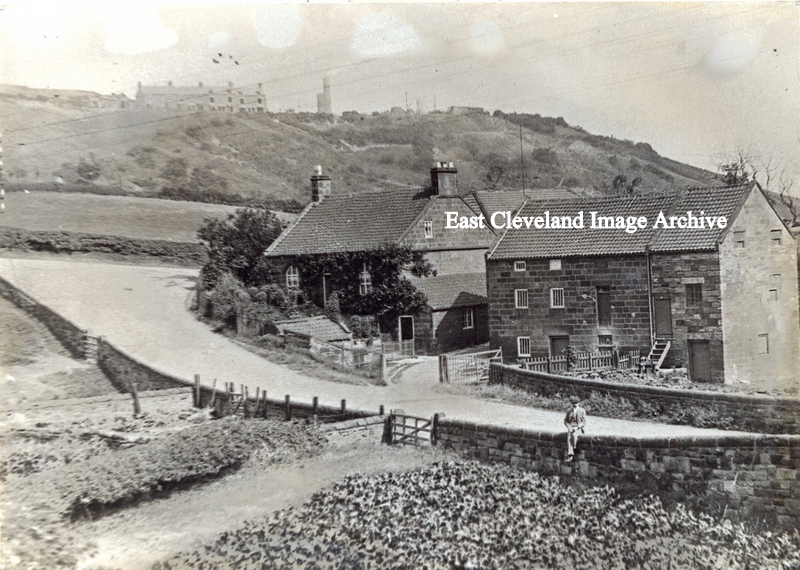
An early 20th century photograph of Kilton Mill. The old road layout at the bottom of Mill Bank is clearly seen, the gentleman sitting on the wall would now be in the middle of the new road; the mill would still be working at this date. Image courtesy of Alan Richardson. |
||
Recent Comments